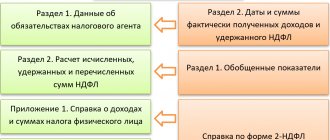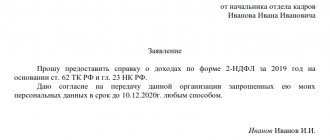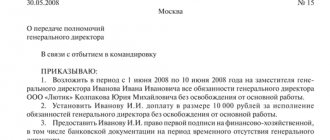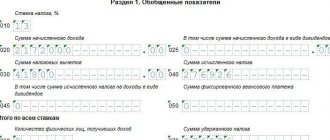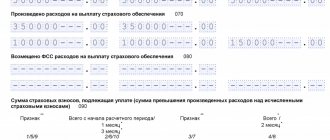Like ordinary citizens, individual entrepreneurs (IP) also fill out and submit tax returns prepared in accordance with Form 3-NDFL.
With the help of this document, individuals officially carrying out business activities report to the state on the payment of income tax. In turn, the tax department controls the income of individual entrepreneurs.
To be more precise, individual entrepreneurs operating under the general tax regime (OSNO) indicate their own income in 3-NDFL, from which, however, personal income tax (personal income tax) has not yet been levied.
In addition to business income, other earnings of individual entrepreneurs (for example, income from renting out real estate for temporary use) can be recorded in the same declaration.
It is necessary to understand under what circumstances individual entrepreneurs report under 3-NDFL, and also find out how such declarations are generated and submitted by individuals - business entities.
Who submits the 3-NDFL declaration
The Tax Code of the Russian Federation determines that individuals who calculate and pay 3-NDFL independently need to fill out the 3-NDFL declaration.
These include:
- Tax-registered entrepreneurs using OSNO.
- Civil servants and members of their families.
- Notaries, lawyers, doctors, etc. in private practice.
- Individuals who received income in the form of winnings this year.
- Individuals who received income in the current period from the sale of property. Most often, this is when selling a car or real estate.
- Individuals who register with the Federal Tax Service for property and social deductions.
- Persons recognized as residents of Russia when they receive income abroad.
- Citizens of foreign countries operating on the basis of a patent.
- Individuals for whom the tax agent was unable to withhold personal income tax.
- Persons receiving royalties for works of art, science, literature, inventions, etc. created by them.
- Individuals whose source of income is other individuals and organizations that are not tax agents.
Employees of the enterprise and entrepreneurs carrying out activities under labor and civil contracts do not have to submit this declaration. Their employers submit an annual 2-NDFL report for them.
However, if they want to make a tax refund in connection with the use of property or tax deductions, then, based on certificates from employers, they need to submit a 3NDFL report to the Federal Tax Service.
Attention! If individual entrepreneurs apply special tax regimes, then in some cases they need to submit this form, even when there is an exemption due to the system used. For example, when selling property or receiving winnings.
In some cases, individual entrepreneurs must also prepare a report, Form 4-NDFL.
Online report preparation
To fill out 3-NDFL online, you must have a registered personal account as an individual taxpayer. The login and password for this service are obtained from the Federal Tax Service after specifying all personal data during registration.
Many operators of accounting services offer users convenient programs with instructions on how to fill out an income tax return online for subsequent sending via the Internet or for printing on paper. This method is preferable for those taxpayers who are not involved in accounting and do not have experience filling out reports, although specific knowledge is not required to correctly enter data into this form.
Deadline for submitting the 3-NDFL declaration in 2021
The legislation establishes that the 3-NDFL tax return must be submitted in the general manner by an individual before April 30. This rule applies to individual entrepreneurs registered with the Federal Tax Service. If such a day falls on a weekend or holiday, the final deadline for submitting the report is postponed to the next nearest business day.
In 2021, individuals and individual entrepreneurs will have to report for 2021 by April 30, 2021 inclusive.
Violation of this deadline is possible only for individuals whose tax agents have calculated and filed taxes for them, and the citizens themselves submit a form to receive deductions.
Attention! If an entrepreneur applying the general taxation system (OSNO) closes an individual entrepreneur and is removed from tax registration, then he must fill out the 3-NDFL form within five working days from the date of deregistration.
Do I need to submit 3-NDFL for individual entrepreneurs on OSNO, USN, UTII?
An individual entrepreneur chooses a suitable tax payment system upon registration; in the future, he can change it from the beginning of any year.
Depending on the chosen taxation regime, the composition of the reporting changes.
In general, there is a general regime (OSNO) and special ones (USN, UTII, PSN). In each tax system, taxes are paid differently, and accordingly, reporting on them is different.
Obligation to submit individual entrepreneur reports depending on the tax regime:
- Individual entrepreneurs on OSNO are required to submit Form 3-NDFL, which shows income for the year from activities as an entrepreneur (if the option of paying 6% of income is chosen), or income and expenses (if the option of paying 15% of profit is chosen).
- Individual entrepreneurs using the simplified tax system (simplified system) do not fill out the 3-NDFL declaration; such entrepreneurs pay the simplified tax system and fill out a declaration for the simplified regime.
- Individual entrepreneurs on EVND (imputed income) also do not fill out form 3-NDFL; these individuals pay tax on imputed income, which is calculated according to special rules. A separate UTII declaration form has also been developed for those imputed.
- Individual entrepreneurs for the PSN (patent system) 3-NDFL are not formed; these individual entrepreneurs pay for the patent and do not file any reports on the patent.
Conclusion: the 3-NDFL declaration must be submitted only by those individual entrepreneurs who have chosen the general taxation regime (OSNO) to conduct their business.
New income declaration form for 2021
An important point is that Form 3-NDFL has been updated since the beginning of 2021, so for 2021 entrepreneurs are required to file a declaration using the updated version.
.
The form itself was approved by Order of the Federal Tax Service of Russia No. ММВ-7-11/ [email protected] dated 10/03/2018 and edited by Order No ММВ-7-11/ [email protected] dated 10/07/2019.
The changes affected the second, fifth and seventh appendices, and the barcodes of the declaration pages were also adjusted - changes in the new form 3-NDFL 2021.
Due in 2021
Individual entrepreneurs submit reports on their income once a year.
The last day to submit 3-NDFL to the Federal Tax Service for 2021 is April 30, 2020.
The place of submission is the Federal Tax Service branch where the individual is registered as an individual entrepreneur (at his place of residence).
Violation of the deadline for submitting the declaration leads to a fine of 5% of the unpaid tax amount for each overdue month (the minimum fine is 1000 rubles, the maximum is 30% of the unpaid tax) - Article 119 of the Tax Code of the Russian Federation.
Failure to pay the individual income tax on time also leads to the accrual of penalties, which are calculated as 1/300 of the refinancing rate of the amount not paid on time. From the 3rd day of debt, the rate increases to 1/150 - Article 75 of the Tax Code of the Russian Federation.
Some individual entrepreneurs do not operate at all during the year, in this case they are also required to submit a declaration, but with zero indicators - a sample zero 3-NDFL for individual entrepreneurs.
Entrepreneurs on OSNO are required to report to the Federal Tax Service, regardless of whether they had income in the year or not, whether they were operating or not. The very status of an individual entrepreneur obliges an individual to fill out form 3-NDFL.
Submission methods
Individual entrepreneurs have several ways to register 3-NDFL:
- paper version - fill out a printed form or print out a form filled out on a computer;
- electronic version - an electronic declaration is drawn up in the taxpayer’s account and transmitted via electronic communication channels;
- in the Declaration 2021 program on the tax website - a special free program is downloaded, after which the necessary data is filled in, after which the completed sample can be used for filing.
You can bring the paper declaration yourself to the tax office at the place where the individual entrepreneur is registered, you can send your authorized representative in your place (a power of attorney from the entrepreneur is issued for him), or you can send it by a valuable letter with a list of the attachments.
Where are the reports submitted?
Declaration 3-NDFL for 2021, as in previous periods, must be sent to the tax authorities located at the place of permanent residence of the individual, that is, according to registration.
To determine exactly which tax office you need to report to, you can use the service on the website of this authority. In the appropriate fields, the individual must enter his address from the directory, and the site will tell him which institution he should contact.
However, persons who file 3rd personal income tax are not required to submit the 3rd personal income tax report at their address.
Personal appearance at the tax authority
Methods for filing a declaration can be divided into 3 methods. The first is the personal appearance of the responsible person at the tax authority at the place of registration and the direct delivery of documents to the tax inspector. This method is convenient because a gross error or lack of documents will most likely be noticed by the inspector immediately and promptly corrected by the person in charge. But, at the same time, the method is not suitable for those who do not have time to go to the authorities or cannot be in the city (or other locality) where they need to submit a declaration.
It must be taken into account that the human factor can also have an impact on personal appearance: sometimes inspectors refuse to accept documents, although there are no official grounds for this. In rare cases, they require a document that the taxpayer is not required to provide. And such documents, as a rule, take longer to check than those received by mail or through the website of the federal tax service.
Personal Area
Postal delivery
The second common method is submitting documents by mail. To do this, all the necessary documents are sent by mail and take the individual entrepreneur less time than going to the Federal Tax Service. In this case, inspectors must indicate the reason for refusing to accept documents in writing. Additional documents are obtained through an official request. In addition, this method is the most convenient when personal appearance at the tax authority is impossible.
Individual entrepreneur on the Federal Tax Service website
An even faster and easier way. Since 2015, there is no need to have an electronic digital signature for this. You need to create a personal account and, following step-by-step instructions, send documents. The advantage over regular mail is that it does not require time even to transport documents by the postal service. The documents are instantly received by the tax authority, and returns and any other operations are also carried out via the Internet without the requirement for personal appearance of the individual entrepreneur.
Note! All this is completely free and as fast as possible.
Reporting Methods
The taxpayer has the right to send a report to the Federal Tax Service in several ways:
- Directly to the inspector personally - the individual draws up a report in two copies and submits it to the Federal Tax Service. After receiving the report, he is left with a second copy with a tax mark.
- Through a representative - this method is similar to the previous one, only reports to the Federal Tax Service are submitted not by the individual entrepreneur or citizen himself, but by the person for whom the power of attorney is issued.
- When sent through a post office, the report is placed in an envelope, which must also contain a description of the contents. After this, you must send it by registered mail.
- Through an electronic document management system - for this method you must have a qualified electronic digital signature (EDS). If the report is submitted through a specialized program, then a special operator agreement is also required.
Is it possible to request a certificate from the Federal Tax Service?
The Tax Code or the administrative regulations of the Federal Tax Service do not contain information about actions to certify the income of individual entrepreneurs by tax authorities. However, many regional inspectorates issue such certificates at the request of the taxpayer.
What is the procedure in this case:
- Draw up an application in any form for the issuance of an income certificate.
- Go to the operating room of the tax office, where declarations are submitted.
- One copy of the application remains with the tax office, the second with an acceptance mark is returned to the applicant.
- Within a month, you can receive either a certificate or an answer about the impossibility of issuing it.
- It will not be possible to appeal the actions of the inspectorate, since the issue is not regulated by law.
Sometimes a self-drafted certificate is also attached to the application, and the tax officer only verifies the data and certifies it with his signature and seal.
Basic rules for filling out the declaration
The procedure for preparing the 3-NDFL report is established by the relevant instructions:
- The report can be generated on a computer or filled out manually on a printed form. Blue or black ink should be used.
- If the declaration is drawn up using a computer, then the Courier New font should be used, and the size should be 16-18 points.
- When filling out 3-NDFL, you need to remember that it should have one page per sheet. Duplex printing cannot be used. Each sheet of the declaration is numbered, and the title page must have the number “001”. In addition to the number, the TIN must be present on each sheet of the report.
- The data in the declaration must be transferred from the relevant supporting documents, which can be 2-NDFL certificates, settlement and payment documents.
- Data in reporting must be entered in such a way that only one character is present in the field.
- When a voluminous report is compiled and there is not enough space for information on one page, then another sheet of the same type is filled out.
- It is not permitted to correct errors in this reporting. If it was admitted, then the report should be completed again.
- Cost indicators should be expressed in rubles and kopecks. In this case, the tax amount is fixed without kopecks.
- Numeric and text fields must be filled out starting from the left cell.
- If the report contains appendices, the number of their pages should be indicated on the title page.
You might be interested in:
Information on the average number of employees: sample filling, form
Form and example of filling out form 3-NDFL for 2021
Download the 3-NDFL declaration form for free for 2021 in Excel format.
Download a sample of filling out form 3-NDFL in Excel format.
Attention! At the moment, the article presents the old form used to report in 2021. On December 15, 2021, Federal Tax Service Order No. ММВ-7-11/822 was published, which introduces a new modified reporting form in 2021. For the order to enter into legal force, 2 months must pass from the date of publication.
When are advance payments made?
Before submitting reports for the year, the individual entrepreneur is required to make advance payments in the following periods:
- From January 15 to July 15 for the half year;
- By September 15 for the period July-September;
- A quarter of the annual advance payment is due by January 15th.
4-NDFL for individual entrepreneurs on OSNO - deadlines, rules for filling out the form
The amounts of these advance payments are calculated independently by the tax agent and included in the notifications that are received by the individual entrepreneur. And according to this notification, payments must be made. If the notification does not arrive within the prescribed period, you must contact a tax agent.
The calculation is made on the basis of 4-personal income tax, if the individual entrepreneur had no profit last year (usually the first 2 years of the individual entrepreneur’s existence), or based on the results of the previous reporting year. The calculation mainly involves calculating the expected income in the current reporting year.
Note! In 2021, the procedure for making advance payments will be changed. You can view the changes on the Kontur Extern website and on the Federal Tax Service website.
Sample of filling out the 3-NDFL declaration
An entrepreneur who reports for income received must fill out the title page, sheets with sections 1 and 2, as well as sheet B.
Title page
You need to fill out the sheet from the top, where the entrepreneur’s TIN is recorded. Below is a field for the sheet serial number.
The “Adjustment number” field is filled in as follows:
- If the declaration is submitted for the first time, then “0” is written in the first cell, and the rest are crossed out.
- If it is necessary to submit a clarifying report, a number indicating the adjustment number is entered here. In this case, filling must also be done from the first cell.
The value “34” is entered in the “Tax period code” column, which means that the form is provided for the calendar year. The next column indicates the year itself. Next, you need to enter the Federal Tax Service code where the report is sent; it consists of four digits.
After this comes the subsection “Information about the taxpayer.” The first step is to indicate the code of the country whose citizenship the individual entrepreneur has. For Russia, “643” is indicated here.
In the “Payer Category Code” field, you must indicate “720”, indicating that the declaration is being submitted by an entrepreneur.
Next there are three lines where you need to enter your full name. no abbreviations. The middle name is recorded if available. For foreigners, it is allowed to enter this information in Latin letters.
After this, you need to write down the date and place of birth.
Next comes a subsection with information about the identity document. In the “Document Code” field, its digital designation is written. For example, 10 is a foreign passport, 21 is a Russian passport, etc.
Next are the columns in which you need to enter information about this document - its number and series, when and who issued it.
The following can be entered in the “Taxpayer Status” field:
- “1” – if the individual entrepreneur is a resident.
- “2” – the entrepreneur is not a resident.
Next comes a subsection for specifying the address.
First you need to enter a code that determines which address is indicated in the document:
- “1” – if place of residence.
- Or “2” – if the place of stay.
After this, the elements of the address are entered in specially designated columns - region code, name of the locality, streets, etc. This must be done in strict accordance with the information from the identity document.
If a foreign entrepreneur does not have an address in Russia, there is a field below for writing his foreign data.
Next, you need to write down the phone number for the contact and the number of pages that make up the document. The last indicated column is best filled out after the entire declaration has been drawn up and its volume is known exactly. Nearby is a field in which you need to enter the number of sheets with attachments. These include, for example, a power of attorney if the report is submitted by an authorized person.
At the end, the form is divided into two parts, and only the left one needs to be filled out.
Here is the code indicating who submits the form:
- “1” – the individual entrepreneur himself.
- or “2” – his authorized representative.
Attention! The entrepreneur simply signs and dates it, and the authorized representative also writes down his full name and also indicates the details of the power of attorney.
Section 1
The entrepreneur’s TIN and the number of the sheet in the general bundle are written at the top. Next, indicate the full surname and initials.
Line 010 usually contains the value “1” - the tax to be paid is calculated. Code “2” indicates a tax refund and is used for deductions, and code “3” is used for a zero report.
In line 020 the KBK code is entered, according to which the tax is transferred.
In line 030 you need to write down the OKTMO code in whose territory the entrepreneur transfers the tax.
Line 040 contains the amount of tax that needs to be transferred.
You might be interested in:
Form P-4 NZ in statistics: sample filling
Line 050 is crossed out - it is used when returning.
At the end, the sheet must be certified by the signature of the entrepreneur.
Section 2
Filling out the section begins again by indicating the TIN, sheet number and full name. entrepreneur.
Line 001 - the tax rate is recorded, for a resident it is “13”.
Line 002 indicates the income receipt code. For entrepreneurial activity it is “3”.
Line 010 records the total amount of income received during the reporting period. It does not include income from foreign companies.
Line 020 is filled in if income was received that is not subject to taxation.
Line 030 is the amount of income on which tax must be calculated. It is calculated as the difference between lines 010 and 020.
If an entrepreneur uses standard or professional deductions, their amount must be recorded in line 040.
If an entrepreneur has expenses by which the base can be reduced (for example, during transactions with securities), their amount is indicated in line 050.
Line 051 records income from the profits of controlled foreign companies.
The tax base for line 060 is determined by the formula: lines 030+051-040-050.
Next, the tax itself is calculated.
Line 070 is the base of line 060 multiplied by the rate of line 001.
If a certain amount of tax has already been withheld, it is indicated in line 080.
Line 090 is filled in only for a rate of 35%. In the usual case, it is crossed out.
Line 091 records the amount of the trade fee if it was paid by the entrepreneur. This amount cannot exceed the value of line 070.
Line 100 indicates the amount of advance tax payments already paid.
Line 110 is crossed out - it is filled in for a work patent.
Line 120 enters the amount of tax that has already been paid in other states, but can be offset in Russia.
Line 121 calculates the amount of tax payable. This is done using the formula: lines 070-080-090-091-100-110-120.
In line 122 the amount of tax transferred under the PSN is entered. The entrepreneur crosses out this line on OSNO.
The value from line 121 is transferred to line 130.
Line 140 is intended for tax refunds - in this case, it must be crossed out.
Sheet B
The TIN and serial number of the sheet, as well as the surname and initials of the taxpayer are indicated in the upper part.
In section 1.1 you need to enter a code that determines the status of the taxpayer; for individual entrepreneurs the code is written here
1.
Section 1.2 records the OKVED code that determines the type of activity. From 2021 you need to use OKVED2 codes.
In section 2, the taxpayer reflects the information necessary to calculate the tax.
Line 030 reflects the income received by the individual entrepreneur, and line 040 reflects the expenses incurred by him. Lines 050-100 explain and decipher the data reflected in the previous line.
Section 3 summarizes the results, with line 110 reflecting the entrepreneur’s income, line 120 the amount of deduction, line 130 the amount of accrued advance tax payments, and line 140 the amount paid.
Section 4 needs to be completed only by heads of peasant farms; individual entrepreneurs skip this section.
Point 5 needs to be completed only if the individual entrepreneur independently adjusted the base and personal income tax tax during this time after the expired period.
The page must contain the signature of the taxpayer or his representative, as well as the date the payment was issued.
Composition of the declaration
Order No. ММВ-7-11/569 regulates format 3 of personal income tax for individual entrepreneurs on OSNO. How to fill out the form is described in this article. To make the form easier to find, the form was encoded with the code KND 1151020.
The form consists of a title page, eight appendices and two calculations for the appendix. Filling out the 3rd personal income tax declaration for individual entrepreneurs on OSNO begins with the title page.
In the title book, the declarant writes information about the company, the reporting period, and indicates information about the Federal Tax Service, where the documentation is sent. The design of the main page ends with information about the declarant. Contents of the form:
- Section 1 involves entering information about taxes that need to be paid to the budget or returned from the latter. Depending on the purpose of filing - tax deduction or payment of a fee - the relevant information is indicated.
- Section 2 consists of two subsections: the first calculates the tax base (TB), and the second - the amount of the fee that is subject to payment or refund.
- Appendix 1 is intended to reflect profits from sources located in Russia, since income from other countries is also declared.
- In Appendix 2, the businessman indicates the amounts received from sources abroad. Depending on the type of profit, the fee is calculated at the appropriate rate, which is indicated at the beginning of the page.
- Appendix 3 is intended specifically for individual entrepreneurs and contains 6 subsections: ○ type of activity: here, using the appropriate encodings, the merchant indicates the type of occupation and OKVED; ○ indicators by which NB and the amount of collection are calculated. These are the sums of profits and costs; ○ total amount: the amount of advance payments paid in fact, as well as the amount of professional deduction for the fee; ○ page for peasant farm managers: if a businessman is not one, then there is no need to fill out the sheet; ○ page for entering corrected information that the businessman corrected himself. This is the amount of the fee and NB; ○ calculation of professional tax deductions.
- In Appendix 4, the businessman calculates the income received, which is not subject to taxation.
- Appendix 5 involves calculating various deductions and consists of 5 subparagraphs: ○ standard; ○ social benefits for donations, education of children aged 18-24 years or yourself, as well as for expensive medical services. The last two points are subject to a restriction - the maximum refund amount is 120,000 rubles per tax period. ○ social voluntary insurance, education for a brother or sister aged 18-24, medical services, funds allocated to non-state pension funds, funded pensions, as well as qualification courses; ○ the total amount of standard and social deductions from the previous subparagraphs; ○ investment.
- The sixth appendix contains 8 subsections for calculating returns on property transactions (sale of real estate or its rights). Property, the profit from which is subject to return:
○ residential premises, gardens, dachas, plots, lands or shares;
○ other type of real estate;
○ other type of property (for example, transport);
○ seizure of property for state and municipal needs;
○ property that a merchant acquired during the liquidation of a foreign company or rights to property controlled by a foreign enterprise;
○ calculation of the amount that was actually spent during the transaction and is subject to reimbursement; ○ calculation of funds spent on reducing the nominal price, which are allowed to be returned by law.
○ Appendix 7 is intended to reflect information on the property deduction of money spent on the purchase or construction of a new home. Contains 2 subsections: information about property and expenses, calculation of the amount accepted for reimbursement.
- In Appendix 8, a businessman has the right to calculate the amount of deduction for transactions with securities and derivative financial instruments.
- The last two pages involve calculating profits from real estate trade in Appendix 1 and calculating social deductions for fees in Appendix 5. The last section consists of two subsections where the following are calculated:
○ the amount of insurance contributions for funded pensions, non-state pension funds and voluntary contracts with funds;
○ the total amount of funds for the previous item presented for refund.
Zero reporting
If an entrepreneur did not have taxable income during the reporting period, he still needs to submit 3-NDFL with zero figures to the tax report. Its filling has some peculiarities.
The document must include three pages - title page, section 1 and section 2.
The title page is formatted in a standard manner, as for a simple declaration.
On the sheet with section 2 you must indicate:
- TIN of the entrepreneur;
- Last name and initials;
- Tax rate.
All other columns on this sheet must be crossed out.
On the sheet with section 1, fill in:
- Again, TIN and full name;
- Code “3” is written in line 010 – no tax payment;
- KBK code corresponding to the payment of personal income tax by the entrepreneur;
- OKTMO code.
All remaining columns are also crossed out. After the sheets are completed, they are numbered in order, and each sheet is signed by the individual entrepreneur.
What is an income certificate
An individual entrepreneur’s income certificate is an officially approved document confirming an employee’s income for a specific accounting period, usually a year. An individual needs it to present it upon request, for example, to a bank. To obtain a loan, bank employees often require this document from potential clients.
IP
Sometimes a certificate is needed to obtain:
- benefits;
- certain payments due to certain categories of citizens (poor people, large families, single mothers).
An individual entrepreneur needs a certificate from an individual entrepreneur for an individual entrepreneur for the same purposes. But since he works for himself, it is necessary to study the rules for issuing certificates of this kind specifically for individual entrepreneurs, find out where and how to get information, and how to correctly submit the information received.
Sample certificate of individual entrepreneur
Penalty for failure to submit reports
The Tax Code establishes liability if the 3-NDFL tax return was not submitted on time or was not submitted at all.
Violation of the deadline for sending a document entails a fine of five percent of the amount of tax for each month (both full and partial) that has passed since the deadline for filing. Moreover, its minimum amount is 1000 rubles, and the maximum cannot exceed 30% of the tax amount under this declaration.
If an entrepreneur does not submit a zero declaration, he will need to pay a minimum fine of 1,000 rubles.
Attention! In addition, if an individual entrepreneur does not submit a declaration within 10 days from the expiration of the deadline, then the Federal Tax Service has the right to unilaterally block the conduct of transactions on his current accounts.
